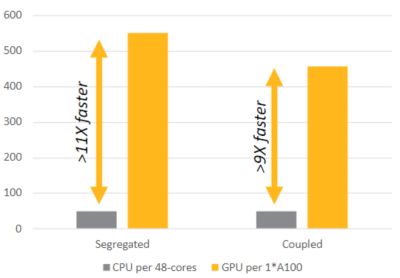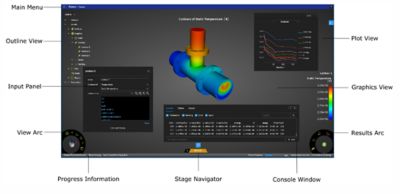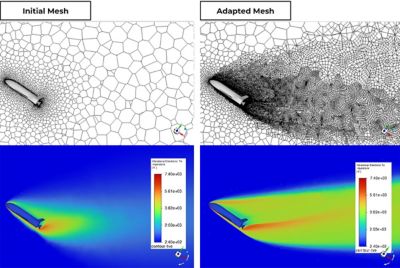-
-
Access Free Student Software
Ansys empowers the next generation of engineers
Students get free access to world-class simulation software.
-
Connect with Ansys Now!
Design your future
Connect with Ansys to explore how simulation can power your next breakthrough.
Countries & Regions
Free Trials
Products & Services
Learn
About
Back
Products & Services
Back
Learn
Ansys empowers the next generation of engineers
Students get free access to world-class simulation software.
Back
About
Design your future
Connect with Ansys to explore how simulation can power your next breakthrough.
Free Trials
ANSYS BLOG
April 5, 2024
What’s New for Ansys Fluent in 2024 R1?
With a new web-based user interface (UI), additional physics to our graphics processing unit (GPU) solver, and many enhancements across aerospace, combustion, and electro-chemical workflows, we are excited to share what’s new in Ansys Fluent 2024 R1 that will help improve and advance your computational fluid dynamics (CFD) simulations.
Download version 2024 R1 at the Ansys Customer Portal.
GPU Solver Updates: New Physics, Models, and Hardware Compatibility
The Fluent GPU solver, released in early 2023, has substantial updates in 2024 R1. These include new physics, modeling enhancements, and GPU hardware compatibility.
You can now choose between segregated or coupled pressure-velocity coupling for your simulations. Because the coupled algorithm solves the momentum equations and continuity equation together in the same system, it significantly improves the rate of solution convergence and is the method of choice for steady-state flows. In addition, far-field boundary conditions for both the segregated and coupled solver are now available, providing optimal setup for external aerodynamics simulations.

DrivAer 50 million-cell benchmark performance showcases that a single NVIDIA A100 GPU is 11 times faster than 48 CPU cores with the segregated solver and nine times faster with the coupled solver.
Nonconformal interfaces and sliding meshes are also now supported in 2024 R1. This means that models can include moving parts, such as designs with rotating wheels, full-wheel turbomachinery, mixing applications, and more. This is an exciting new addition and has applications across multiple industries including automotive, aerospace, pharmaceutical, and others.
With the new nonconformal interfaces and sliding mesh capability, you can now study fluid flow on models with moving parts like this marine propeller simulation.
Combustion studies using the detailed and stiff chemistry solvers are now also available in the Fluent GPU solver. The detailed chemistry solver allows you to study multispecies and multistep reactions, and it is particularly useful for liquid-liquid reactions and pollutants formation. If you are working on automotive engines, gas turbines, fuel cells, or similar technologies, this capability will allow you to run these studies exponentially faster than running them on central processing unit (CPU) hardware.
The stiff chemistry solver has been optimized to run on GPUs and enables large meshes and reaction mechanisms. For example, when running a 2.6 million-cell laminar model of premixed ignition at elevated temperatures with 23 species and 102 reaction mechanisms, we’ve seen the same results on both the GPU solver and CPU solver — but the GPU solver finished nine times faster.
We are also excited to announce that there is now beta support for AMD GPUs. Beta support is available on Linux operating systems, and benchmark studies have been completed to validate performance speedups on AMD cards.
These are just a few of the updates available within the Fluent GPU solver in 2024 R1. Watch the “Ansys 2024 R1: Ansys Fluent GPU Solver Updates” webinar on demand to learn more.

The new Ansys Fluent web user interface (UI) has a modern and immersive feel with capabilities and features that enable you to monitor simulation results, as well as pause, edit, and restart jobs in real time from a web browser on any device.
A new Fluent web-based user interface (UI) is now available that lets you control Fluent jobs directly from your web browser while connected to a Fluent server running on local or remote resources. The Fluent web UI allows you to remotely monitor simulations as the job is running, make setup adjustments in real time, and post-process results without moving heavyweight data back to your local workstation or laptop. This is particularly useful when running on remote hardware. For example, when running a Fluent case on a cluster, you can easily monitor the progress from home and make quick settings changes using your web browser.
Fluent web UI features include:
- The ability to connect and disconnect from the server.
- Support for multiple simultaneous connections from either same or different browsers or machines.
- A remote file browser.
- The ability to pause and resume the job.
- A rich context menu based on graphics selection.
- The ability to change boundary conditions, solution controls, and more during calculation.
- The ability to create, edit, and display graphics objects during calculation.
- Optimized solution monitors in which only what is displayed is updated.
- Python journaling of most UI actions.
- Support for scenes with transparencies.
Watch the “Ansys 2024 R1: Ansys Fluent User Experience and Usability” webinar to learn more.
Aerospace Application Enhancements
With Ansys Fluent, you can simulate lift, drag, wall shear, turbulence, and more for a wide range of flight conditions.
Fluent has robust solutions across the aerospace industry, particularly for external aerodynamics studies for low- to high-speed flight regimes. In 2024 R1, enhancements have been made to improve solver performance, meshing, and the Fluent Aero workspace.
For users working on space applications including satellites and re-entry vehicles, new material properties and reaction mechanisms have been added for Venus and Titan atmospheres. This enhancement will improve simulation accuracy when studying designs in non-Earth planetary environments. Accuracy is critical since simulation is often the only solution to predict how a design will perform outside of Earth’s atmosphere.
Meshing improvements have also been made when working with 2D meshing workflows. Quad elements with prism layers are now supported, and Hessian predefined parameters have been improved for polyhedral unstructured mesh adaption (PUMA). These meshing updates will enhance simulation accuracy by resolving common flow features such as shocks, waves, vortices, etc., at a wide range of Mach numbers.

PUMA with Hessian pre-defined parameters at Mach = 19 (right) shows advanced complexity and fidelity compared to the initial mesh. There is increased fidelity of the vibrational-electron temperature field in the wake due to presence of multiple shocks.
Finally, updates to the Fluent Aero workspace include enhancements to the Aerodynamics Extraction Tool (AET) workflow for virtual blade model (VBM) preprocessing, including improved computer aided design (CAD) generation of airfoils, a restart mesh generation step, and a new ribbon for easy access to a desired workflow step. In addition, there is now an autodetect transition from continuum hypothesis to free molecular regime to automatically apply proper best practices. This is important for high-speed conditions such as re-entry. Finally, aerodynamic forces and coefficients can now be displayed in wind-fixed frame or body-fixed frame of reference.
Register for the “Ansys 2024 R1: Ansys Fluent for Aerospace Applications” webinar to learn more.
Combustion Studies
Attached hydrogen flame (left) and lifted hydrogen flame (right) simulated in Fluent.
Accurately solving reacting flow applications can be challenging due to the complex physics involved, such as unsteady flow field and heat transfer. In 2024 R1, best practices have been incorporated into the Fluent solver to help users efficiently model and solve complex combustion studies. Best practices have been developed for hydrogen and hydrogen blend combustion to accurately predict flame position, flashback, and emissions. This will be beneficial for engineers working on designing new carbon-free combustors. Additional best practices were created for ammonia and ammonia blend combustion modeling. These practices were developed from several canonical test cases and validated with industrial examples. Such best practices leverage the automatic mesh refinement capabilities in Fluent.
In addition, the thickened flame model (TFM) is now supported via the Ansys Chemkin CFD solver, allowing you to use any mechanism derived from the encrypted model fuel library (MFL) mechanism with the TFM model.
Watch the “Ansys 2024 R1: Ansys Fluent Physics and Modeling Updates” webinar to learn more.
Thermal Abuse Simulation and Modeling Updates
Thermal runaway from nail penetration modeled using Fluent
Thermal runaway is a major safety concern for lithium-ion batteries (LIBs). As LIBs are used in more advanced applications in which hundreds of thousands of cells are necessary, it is critical to understand how the heat generated can result in thermal runaway propagation and make necessary design changes to avoid such risks. Accurate models are required to simulate the heat transfer between cells, and Fluent has new enhancements in 2024 R1 to improve simulation and analysis of these types of studies. In 2024 R1, two additional thermal abuse kinetic models have been added:
- Table: enables users to input accelerating rate calorimetry (ARC) data as a lookup table directly into Fluent. This is very useful for situations in which the Arrhenius model does not fit the ARC data well and thus cannot be used for accuracy.
- User-defined function (UDF): gives users ultimate control over the kinetics models desired. For instance, you could use this option to implement a piecewise Arrhenius model.
In addition, there is also a new direct current internal resistance (DCiR) battery sub-model that is built into Fluent 2024 R1. This is especially useful when running fast-charge simulations used in applications like electric vehicle (EV) charging.
Watch the “2024 R1: Ansys Fluent Physics and Modeling Updates” webinar to learn more.